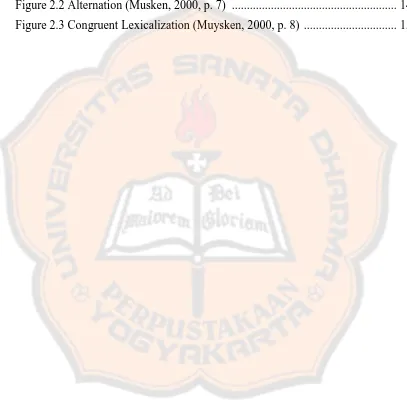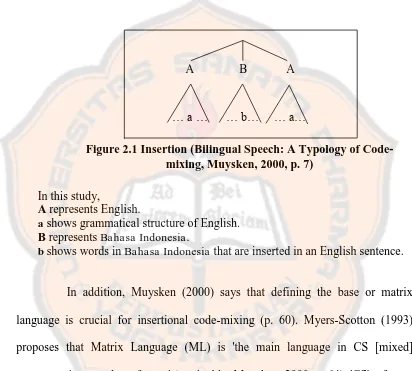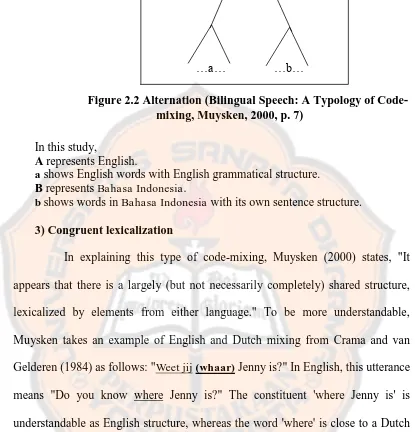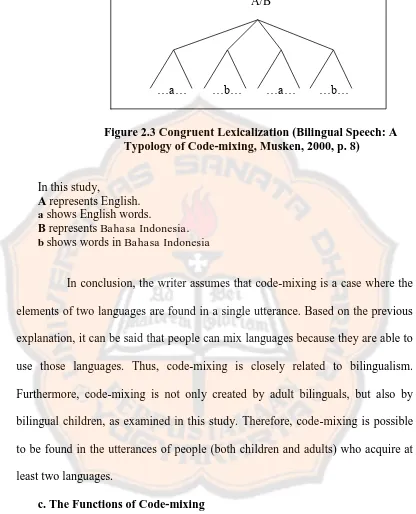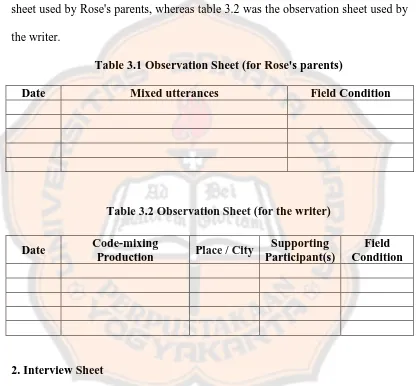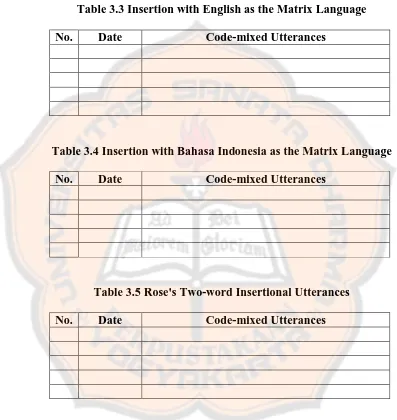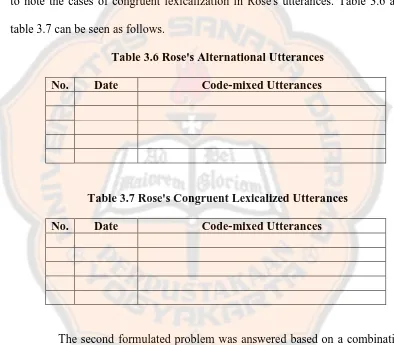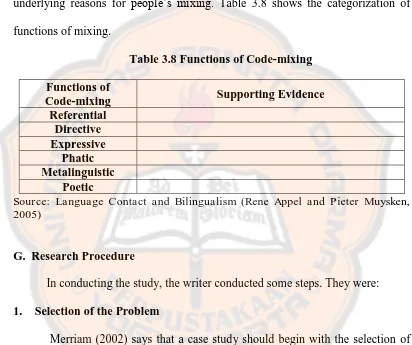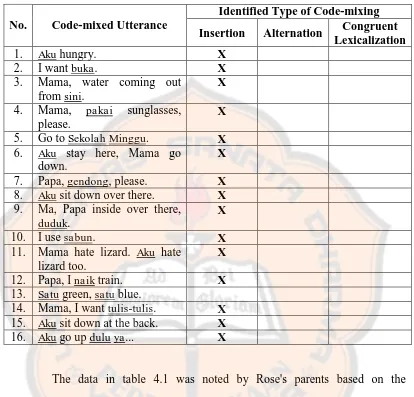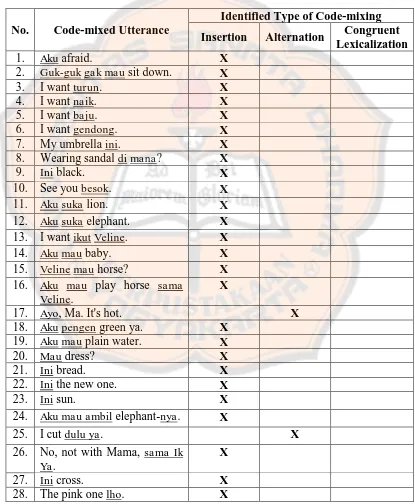A CASE STUDY ON THE CODE-MIXING IN
A BILINGUAL CHILD’S
UTTERANCES
A SARJANA PENDIDIKAN THESIS
Presented as Partial Fulfillment of the Requirements to Obtain the Sarjana Pendidikan Degree
in English Language Education
By Liliana
Student Number: 091214023
ENGLISH LANGUAGE EDUCATION STUDY PROGRAM DEPARTMENT OF LANGUAGE AND ARTS EDUCATION FACULTY OF TEACHERS TRAINING AND EDUCATION
SANATA DHARMA UNIVERSITY YOGYAKARTA
i
A CASE STUDY ON THE CODE-MIXING IN
A BILINGUAL CHILD’S
UTTERANCES
A SARJANA PENDIDIKAN THESIS
Presented as Partial Fulfillment of the Requirements to Obtain the Sarjana Pendidikan Degree
in English Language Education
By Liliana
Student Number: 091214023
ENGLISH LANGUAGE EDUCATION STUDY PROGRAM DEPARTMENT OF LANGUAGE AND ARTS EDUCATION FACULTY OF TEACHERS TRAINING AND EDUCATION
SANATA DHARMA UNIVERSITY YOGYAKARTA
2013
PLAGIAT MERUPAKAN TINDAKAN TIDAK TERPUJI
iii
PLAGIAT MERUPAKAN TINDAKAN TIDAK TERPUJI
iv
When things go wrong, as they sometimes will,
When the road you're trudging seems all up hill,
When the funds are low and the debts are high,
And you want to smile, but you have to sigh,
When care is pressing you down a bit,
Rest, if you must --- but don't you quit.
Success is failure turned inside out
The silver tint of the clouds of doubt
And you never can tell how close you are,
It may be near when it seems afar,
So stick to the fight when you're hardest hit
It's when things seem worst that you mustn't quit.
-Author Unknown-
v
PLAGIAT MERUPAKAN TINDAKAN TIDAK TERPUJI
vii ABSTRACT
Liliana. (2013). A Case Study on the Code-mixing in a Bilingual Child's Utterances.
Yogyakarta: English Language Education, Department of Language and Arts Education, Faculty of Teachers Training and Education, Sanata Dharma University.
Many parents nowadays are very aware of the importance of English. Therefore, many of them attempt to have their children educated in English. This awareness brought Mr. and Mrs. X to raise their daughter, Rose, bilingually. Rose has been exposed to both Bahasa Indonesia and English concurrently since she was born. However, when she began to speak, she mixed those languages in her utterances, which is called code-mixing.
With regard to this language phenomenon, this study is aimed to discover the types of code-mixing found in Rose's utterances and to discover the possible reasons for her code-mixing. The writer applied some theories related to this study, namely, Muysken's (2000), Appel and Muysken's (2005), and Hakuta's (1986) theory.
This study belonged to case study. It employed participant-observations since the writer needed to observe Rose's mixed utterances without any manipulation and an interview to gain supporting information from the parents. Observation sheets and an interview sheet were the instruments to note the data for this study. Afterwards, the noted mixed utterances were classified based on Muysken's theory in order to address research problem number 1, whereas the interview results were combined with Hakuta's theory and Appel and Muysken's theory to address research problem 2. The research was conducted during September 2012 to May 2013.
The result of this study described that Rose created two out of three types
of code-mixing, namely, insertion and alternation. Based on the results, there is a possibility that she mixed the languages due to imitating others. This imitation was resulted from the fact that Rose was surrounded by people who mixed both English and Bahasa Indonesia. This condition made the act of mixing become a normal thing for Rose. This condition is called mixed identity. On the other hand, compound bilinguals have more tendency to mix language because the change of language will not affect the meaning they want to deliver. In other words, both languages acquired by the compound bilinguals are interchangeable in their mind. Therefore, they have more tendency to mix compared to coordinate bilinguals. Since Rose was a compound bilingual, she also had the tendency to mix.
Regarding the research results, people who interact with bilinguals should maintain the appropriate use of language in order to avoid code-mixing. If it happens that the bilinguals do not understand the meaning of an utterance, it will be better to translate rather than to mix.
Keywords: code-mixing, bilingualism, utterance.
PLAGIAT MERUPAKAN TINDAKAN TIDAK TERPUJI
viii ABSTRAK
Liliana. (2013). A Case Study on the Code-mixing in a Bilingual Child's Utterances.
Yogyakarta: English Language Education, Department of Language and Arts Education, Faculty of Teachers Training and Education, Sanata Dharma University.
Orangtua pada masa sekarang ini telah menyadari pentingnya Bahasa Inggris. Oleh karena itu, banyak orangtua berusaha untuk mengedukasi anaknya dengan Bahasa Inggris. Kesadaran tersebutlah yang mengantarkan Bapak dan Ibu X untuk membesarkan putri mereka, Rose, dalam lingkungan kedwibahasaan. Rose dipaparkan baik pada Bahasa Indonesia, maupun Bahasa Inggris secara bersamaan sejak baru saja lahir. Akan tetapi, ketika dia mulai belajar berbicara, dia mencampur kedua bahasa tersebut dalam ucapannya, yang lebih dikenal dengan sebutan campur
kode (code-mixing).
Sehubungan dengan fenomena bahasa tersebut, penelitian ini ditujukan untuk menemukan jenis-jenis code-mixing yang ditemukan dalam ucapan-ucapan Rose and juga menemukan alasan-alasan yang memungkinkan Rose melakukan campur kode. Penulis menggunakan beberapa teori dalam penelitian ini, yaitu teori dari Muysken (2000), Appel dan Muysken (2005), dan Hakuta (1986).
Penelitian ini merupakan studi kasus. Penelitian ini menggunakan
observasi-partisipatoris (participant-observation) karena penulis harus
mengobservasi ucapan-ucapan Rose yang bercampur kode tanpa adanya unsur manipulasi dan wawancara untuk menggali informasi yang mendukung dari orangtuanya. Lembar observasi dan lembar wawancara adalah instrumen yang digunakan untuk mencatat data dalam penelitian ini. Ucapan-ucapan yang bercampur kode kemudian diklasifikasikan berdasarkan teori Muysken untuk menjawab permasalahan pertama. Hasil wawancara dikombinasikan dengan teori Hakuta dan Appel dan Muysken untuk menjawab permasalahan kedua. Penelitian ini dilakukan dalam kurun September 2012 sampai dengan Mei 2013.
Hasil dari penelitian ini menjelaskan bahwa Rose membuat dua dari tiga
jenis campur kode, yaitu insertion dan alternation. Berdasarkan hasil penelitian ini,
ditemukan adanya kemungkinan bahwa Rose mencampur kedua bahasa tersebut karena menirukan orang lain. Peniruan ucapan ini disebabkan oleh fakta bahwa Rose berada di lingkungan dengan orang-orang yang melakukan campur kode.
Kondisi ini dikenal dengan sebutan identitas campuran (mixedidentity). Di samping
itu, dwibahasawan majemuk memiliki kecenderungan untuk mencampur bahasa karena perubahan bahasa tidak mempengaruhi makna yang ingin disampaikan. Dengan kata lain, kedua bahasa yang mereka gunakan dapat saling mengganti. Oleh karena itu, mereka lebih mempunyai kecenderungan untuk mencampur bahasa jika
dibandingkan dengan dwibahasawan koordinat (coordinate bilinguals). Oleh
karena Rose merupakan seorang dwibahasawan majemu, dia juga mempunyai kecenderungan untuk mencampur bahasa.
ix
dari sebuah ucapan, pemberian terjemahan akan lebih baik daripada pencampuran bahasa.
Kata kunci: campur kode, kedwibahasaan, ucapan.
PLAGIAT MERUPAKAN TINDAKAN TIDAK TERPUJI
x
ACKNOWLEDGMENTS
First of all, I would like to thank the Almighty God for His blessings in my life. I felt His wonderful inclusion during the making of this thesis. This experience has taught me to hand everything to Him and believe in His plans.
My deepest gratitude for my advisor, Dr. Retno Muljani, M. Pd., who has helped me from the beginning until the end of this thesis. I thank her for her
guidance, patience, and support for my progress.
I owe a great debt to my oldest sister, Dwiana Sari, for her permission to make her daughter, Giovana Adelynn Sugiarto, the subject of this study, and also
for her help and support during the accomplishment of this thesis.
I am deeply indebted to my beloved family: my mother Rahayu
Trisyaningsih and my father Iswanto, Dwiana Sari and family, Triana Dewi and family, Listiyany, and Henry Setiawan, who become my big spirit in finishing my study. My special lovely thanks are also given to my beloved friend, Novan
Akhmad Nugroho, for being the best companion during my study in Sanata Dharma University.
My gratitude also goes to all friends from 'Persus Croc' who always brighten my days, to all 'Bravo Insegnate' members for their kindness, support, and togetherness, and to all friends from Sanata Dharma University. I also thank
those who have helped and supported me that I cannot mention all here by name.
xi
TABLE OF CONTENTS
Page
TITLE PAGE ... i
APPROVAL PAGES ... ii
DEDICATION PAGE ... iv
STATEMENT OF WORK'S ORIGINALITY ... v
LEMBAR PERNYATAAN PUBLIKASI ... vi
ABSTRACT ... vii
ABSTRAK ... viii
ACKNOWLEDGEMENTS ... x
TABLE OF CONTENTS ... xi
LIST OF TABLES ... xiii
LIST OF FIGURES ... xiv
LIST OF APPENDICES ... xv
LIST OF ABBREVIATIONS ... xvi
CHAPTER I. INTRODUCTION ... 1
A. Research Background ... 1
B. Problem Limitation ... 3
C. Problem Formulation ... 3
D. Research Objectives ... 4
E. Research Benefits ... 4
F. Definition of Terms ... 5
CHAPTER II. REVIEW OF RELATED LITERATURE ... 7
A. Theoretical Description ... 7
1. Bilingualism ... 7
a. Definition of Bilingualism ... 7
b. Typology of Bilingualism ... 8
2. Code-mixing ... 10
PLAGIAT MERUPAKAN TINDAKAN TIDAK TERPUJI
xii
a. Definition of Code-mixing ... 10
b. Typology of Code-mixing... 11
c. Functions of Code-mixing... 15
B. Theoretical Framework ... 18
CHAPTER III. METHODOLOGY ... 20
A. Research Method ... 20
B. Research Setting ... 22
C. Research Participants ... 22
D. Research Instruments ... 24
E. Data Gathering Techniques ... 26
F. Data Analysis ... 27
G. Research Procedure ... 30
CHAPTER IV. RESEARCH FINDINGS AND DISCUSSION ... 32
A. Data Presentation ... 32
1. Data Collected from Observations ... 32
2. Interview Results ... 36
B. Discussion ... 38
C. Other Findings ... 53
CHAPTER V. CONCLUSIONS, SUGGESTIONS, AND IMPLICATION .. 55
A. Conclusions ... 55
B. Suggestions ... 57
C. Implication ... 58
REFERENCES ... 59
xiii
LIST OF TABLES
Page
Table 3.1 Observation Sheet (for Rose's parents) ... 25
Table 3.2 Observation Sheet (for the writer) ... 25
Table 3.3 Insertion with English as the Matrix Language ... 28
Table 3.4 Insertion with Bahasa Indonesia as the Matrix Language ... 28
Table 3.5 Rose's Two-word Insertional Utterances ... 28
Table 3.6 Rose's Alternational Utterances ... 29
Table 3.7 Rose's Congruent Lexicalized Utterances ... 29
Table 3.8 Functions of Code-mixing ... 30
Table 4.1 Rose's Code-mixing Based on Parents' Observations ... 34
Table 4.2 Rose's Code-mixing Observed by the Writer ... 35
Table 4.3 Insertion with English as the Matrix Language ... 40
Table 4.4 Insertion with Bahasa Indonesia as the Matrix Language ... 41
Table 4.5 Rose's Two-word Insertional Utterances ... 43
Table 4.6 Rose's Alternational Utterances ... 44
Table 4.7 Comparison of Compound and Coordinate Bilinguals ... 47
Table 4.8 Functions of Code-mixing ... 50
PLAGIAT MERUPAKAN TINDAKAN TIDAK TERPUJI
xiv
LIST OF FIGURES
xv
LIST OF APPENDICES
Page
Appendix 1. The Interview Sheet... 61
Appendix 2. Observation Sheet (for Rose's Parents) ... 62
Appendix 3. Observation Sheet for the Writer... 63
Appendix 4. Teachers’ Code-mixing (Observation at Rose’s school) ... 70
PLAGIAT MERUPAKAN TINDAKAN TIDAK TERPUJI
xvi
ML Matrix Language
1 CHAPTER I INTRODUCTION
In this chapter, the writer discusses six major parts, namely, the background of the study, problem limitation, problem formulation, research
objectives, research benefits, and definition of terms.
A. Background of the Study
Many people nowadays are aware of the importance of English. Now English is introduced to children much earlier compared to several years ago. In
2000, the writer had the first English lesson in the 4th grade of elementary school,
but today, English has already been introduced to kindergarten students because
many parents want to educate their children in English. This is the fact that many sides are aware of English. In this study, Mrs. X, a housewife living in Semarang, is a graduate of an English department. She has a three-year-and-four-month-old
daughter, Rose. Since she has an English background, is able to communicate in English actively, and is concerned with the importance of English, she decided to
introduce English to her daughter since early time. She began to use English to talk to her baby girl, Rose, since she was newborn. As a result, Rose was already able to produce English simple sentences correctly at the age of two and a half.
On the other hand, Rose’s father cannot speak English well. For that matter, he
often uses Bahasa Indonesia to talk to Rose. This phenomenon then creates a
bilingual situation in the family. Rose speaks English to her mother and mainly
PLAGIAT MERUPAKAN TINDAKAN TIDAK TERPUJI
speaks Indonesian to her father. The situation of the family can be considered as a
bilingual situation since Nababan (1984) defines bilingualism as “Kebiasaan
menggunakan dua bahasa dalam interaksi dengan orang lain.” Fishman (1965)
also supports this definition by stating that bilingualism is "an individual's ability
to use more than one language" (as cited by Cantone, 2007, p. 2).
Children begin with learning words before they are able to produce a single sentence. In other words, after they are able to produce words, they will
start to put the words together and produce a sentence. In this case, Rose knows two different languages at the same time. Thus, when she is able to produce
words, she will also be able to produce simple sentences. However, her
knowledge consists of English and Bahasa Indonesia. As a result, she mixes both
languages within a single sentence.
Mixing languages is known as code-mixing. According to Muysken
(2000), code-mixing is “all cases where lexical items and grammatical features
from two languages appear in one sentence.” He also believes that an ideal
bilingual does not switch languages within a single sentence (p. 1). In other
words, the phenomenon where Rose mixes English and Bahasa Indonesia within
a sentence can be considered as an inappropriate language use because mixing languages is not the appropriate way to speak (Muysken, 2000, p. 1). Therefore,
3
B. Problem Limitation
This study is a case study on the code-mixed utterances created by a
bilingual child. It gives a portrait about a language phenomenon experienced by a
bilingual child. It focuses only on the code-mixing in the child’s utterances. The
main participant of this study is a bilingual child living in Semarang. The child
became bilingual as her parents decided to introduce English and Bahasa
Indonesia to her since she was newborn. Her father often uses Bahasa Indonesia, whereas her mother always uses English when talking to Rose. In her daily conversations, she often mixes both languages in an utterance.
The research discussion is limited to identifying the types of code-mixing
and to finding the reasons for the child’s code-mixing. It focuses on the syntactic
aspect that it attempts to look at the contribution of each language in forming
mixed sentences. The data collection used to address the research problems is
taken from noted observations of the main participant of the study and an
interview with the child's parents.The observations will be conducted in her daily
life interaction with the surrounding people, namely, family members, friends, and
teachers. Those observations will be done during September 2012 to May 2013.
C. Problem Formulation
This study is aimed at addressing the following problems:
1. What are the types of code-mixing created by the bilingual child?
2. What are the possible reasons that may cause code-mixing in her
utterances?
PLAGIAT MERUPAKAN TINDAKAN TIDAK TERPUJI
D. Research Objectives
As stated previously, this study is aimed to examine the tendency of a
bilingual child in mixing languages. The objectives of the study are to identify the types of code-mixing and to discover possible reasons that may cause the
bilingual child to produce code-mixing in her utterances.
E. Research Benefits
This study is expected to give benefits to many people. Firstly, this study is intended to help the parents who want to introduce two different languages to
their children. The results of this study gives an insight about a phenomenon that is potential to happen regarding child bilingualism, namely, code-mixing. This study presents information that will help parents have a view of dealing with child
bilingualism since early time.
Secondly, the results of this study can be used as a reference for teachers
who teach children in international schools. International schools attempt to use English as the main language of communication. However, because children are
surrounded by Indonesian speakers in their daily lives, the tendency of using
Bahasa Indonesia is still high. Therefore, it might lead the children to use both English and Indonesian to communicate at school. Thus, the new knowledge
5
Thirdly, this study is also beneficial to other researchers who are interested in studying code-mixing and child bilingualism. This study provides information
that can be the base of other research on the same topic.
F. Definition of Terms
1. Code-mixing
Plaff (1979) in Romaine's work (1995, p. 124) defines mixing as " a neutral
cover term for both code-switching and borrowing." Grosejan (1998), as cited by Cantone (2007, p. 55), defines code-switching itself as "a complete shift from one
language to the other... " Code-switching can be found at clauses or within clauses (Romaine, 1995, p. 123). Meanwhile, Myers-Scotton (2006, p. 209) states that "When a language takes in words from another language, the process is referred to
as borrowing, ..."
With regard to Plaff's theory, code-mixing in this study is defined as a case
of code-switching and borrowing, or in other words, code-mixing is defined as a phenomenon in which the elements of two languages are combined or used
together in a sentence. This definition is supported by Muysken (2000) stating, "Code-mixing refers to all cases where lexical items and grammatical features from two languages appear in one sentence." Muysken classifies code-mixing into
three types, namely, insertion, alternation, and congruent lexicalization.
2. Bilingualism
According to Fishman (1965), bilingualism is "an individual's ability to use more than one language" (as cited by Cantone, 2007, p. 2). In line with the
PLAGIAT MERUPAKAN TINDAKAN TIDAK TERPUJI
former definition, bilingualism in this study is defined as a situation where the bilingual speaker is accustomed to using two languages in daily life interaction.
3. Utterance
According to Nababan (1984), "Tindak ucapan (utterance acts) ialah kalau
7 CHAPTER II
REVIEW OF RELATED LITERATURE
This chapter discusses two major points, namely, the theoretical description and the theoretical framework. The theoretical description presents the
discussion of the theories used in this study. The theoretical framework focuses on how they are set as the framework of this study to address the research problems.
A. Theoretical Description
This section discusses two major topics, namely, bilingualism and code-mixing.
1. Bilingualism
a. Definition of Bilingualism
The writer proposes the definition written by Nababan (1984) that defines bilingualism as “…menggunakan dua bahasa dalam interaksi dengan
orang lain.” This definition is supported by Fishman (1965), as quoted by Cantone (2007, p. 2), who states that bilingualism is "an individual's ability to use
more than one language." In line with the former definitions, the writer defines
bilingualism in this study as a situation where the bilingual speaker is accustomed to using two different languages in daily life interaction.
PLAGIAT MERUPAKAN TINDAKAN TIDAK TERPUJI
b. Typology of Bilingualism
Weinreich (1953) and Ervin and Osgood (1954), as cited in the work of
Hakuta (1986, p. 95), classify bilingualism into two types, namely, compound and coordinate bilingualism. Each type will be described briefly in the following parts.
1) Compound Bilingualism
According to Hakuta (1986), compound bilinguals are "products of a learning environment where the two languages are used concurrently." He also states, “They tend to fuse the two languages such that, in their mental system,
concepts have verbal labels from both languages attached to them” (p. 95). This
definition is supported by Weinreich (1968), as summarized by Romaine (1995, p.
79), who states, “The compound bilinguals would have one set of meanings and
two linguistics systems tied to them.” Romaine (1995) provides her explanation
with an example of a French-German bilingual. A French-German bilingual
would know both German Buch - 'book' and French livre, but he or she would tie
them into the same mental representation, hence one common meaning (p. 79). Therefore, it is also possible for an Indonesian-English compound bilingual to address both English ‘tofu’ and Indonesian ‘tahu’ as the same because he or she
also has one set of meanings and one mental representation for them.
Based on the explanation of compound bilingualism, the writer can
conclude that compound bilinguals have the tendency to translate words from one language into another language and vice versa with no changes in meaning. It
9
Taking an example as stated before, for English-Indonesian compound bilinguals, the words ‘tofu’ and ‘tahu’ refer to the same mental representation with no
difference in meaning.
2) Coordinate Bilingualism
This type of bilingualism requires a different environment from the previous one. Hakuta (1986) states that coordinate bilinguals learn the two languages in separate environments, most commonly when they are educated in a
language different from their home language (pp. 95-96). Furthermore, Romaine (1995) believes that the words of the two languages are kept separate with each
word having its own specific meaning. This explanation is represented in the example of a French-English bilingual whose first language is English, but then learns French at school. Because the two languages are given to the person in
different contexts, it is believed that different conceptual systems would be developed (Romaine, 1995, pp. 78-79). For example, Romaine says that this
bilingual would have one specific meaning for the term livre which is different
from the meaning of the word book.
Based on Romaine’s theory, the writer concludes that, unlike an English-Indonesian compound bilingual who would take the meaning of the English word ‘tofu’ and Indonesian word ‘tahu’ as the same, a coordinate
bilingual thinks that the English word ‘tofu’ has its own meaning and it is
different from the meaning of the Indonesian word ‘tahu.’ The point here is that
coordinate bilinguals believe that there is a difference in meaning between the languages they acquire.
PLAGIAT MERUPAKAN TINDAKAN TIDAK TERPUJI
In conclusion, it can be seen that there are some different characteristics between the two types of bilingualism. Weinreich (1968) believes that those
differences are resulted from the way in which the languages have been learned (as cited by Romaine, 1995, p. 78). Compound bilinguals, who learn two
languages in the same context, would have a fused representation of the languages in mind (Romaine, 1995, p. 79). On the other hand, coordinate bilinguals learn the two languages in separate environments. Hence, they give different meanings to
the words from each language (Romaine, 1995, pp. 78-79).
2. Code-mixing
a. Definition of Code-mixing
Firstly, the writer will begin by proposing the theory of Plaff (1979), as
quoted by Romaine (1995, p. 124), who defines ‘mixing’ as "a neutral cover term
for both code-switching and borrowing." In the writer’s opinion, following Plaff's
account, the term ‘mixing’ refers to code-mixing. Therefore, code-mixing is
defined as a case of both code-switching and borrowing.
Code-switching itself is defined by Grosejan (1998) as "a complete
shift from one language to the other, ..." (Cantone, 2007, p. 55). The shift can be found at clauses, which is called inter-sentential switching, or within clauses, which is known as intra-sentential switching (Romaine, 1995, p. 123). On the
other hand, Myers-Scotton (2006) states that borrowing is a process when a language takes in words from another language. He also claims that borrowing
11
lexical borrowing deals with the act of borrowing single words from one language in order to be used in another language pattern.
In conclusion, a language phenomenon is called code-mixing if it has the features of code-switching or borrowing. This definition is supported by
Muysken (2000) who states, "Code-mixing refers to all cases where lexical items and grammatical features from two languages appear in one sentence." The following is an example of English-German code-mixing taken from Cantone's
work (2007, p. 70), "I go to the movie with my fratello," which means "I go to the
movie with my brother."
b. Typology of Code-mixing
Code-mixing is classified based on its usage and its emergence. Muysken (2000) classifies code-mixing into three types. They are insertion,
alternation, and congruent lexicalization (p. 3). They are described as follows:
1) Insertion
In describing this type, Muysken (2000) states, "A single constituent B
(with words b from the same language) is inserted into a structure defined by
language A, with word a from that language." In other words, it can be said that in
this type, a word or a phrase of a language is inserted into the grammatical structure of another language. Following Muyksen's account, Cantone (2007)
says, "Inserting an element comes close to lexical borrowing, but whereas
borrowing only covers the insertion of lexical items, insertion can imply larger
structures, such as whole phrases." (p. 69).
PLAGIAT MERUPAKAN TINDAKAN TIDAK TERPUJI
Cantone (2007) gives an example of insertion involving English and
German, "I go to the movie with my fratello." From this example, it is clear that a
German word 'fratello' is inserted into a sentence with English grammatical
structure. The figure 2.1 is the representation of the explanation.
A B A
… a … … b… … a…
Figure 2.1 Insertion (Bilingual Speech: A Typology of Code- mixing, Muysken, 2000, p. 7)
In this study,
A represents English.
a shows grammatical structure of English. B represents Bahasa Indonesia.
b shows words in Bahasa Indonesia that are inserted in an English sentence.
In addition, Muysken (2000) says that defining the base or matrix language is crucial for insertional code-mixing (p. 60). Myers-Scotton (1993)
proposes that Matrix Language (ML) is 'the main language in CS [mixed] utterances in a number of ways' (as cited by Muysken, 2000, p. 64). 'CS' refers to
code-switching. Thus, Matrix Language (ML) is the dominant language and the non-dominant language is called the Embedded Language (EL) (Namba, 2004). Namba also says, "MLs provide abstract grammatical frames where ELs are
13
2) Alternation
This type of code-mixing is different from the previous one, insertion. Insertion deals with how single constituents of one language are inserted into another language pattern, whereas alternation does not only insert some
constituents of a language into another language pattern, but it also involves the grammar of the language (Muysken, 2000, p. 5). Muysken also says that alternation is "a true switch from one language to the other" (p. 5). Based on this
explanation, the writer assumes that alternation is more understandable because the organization is easy to understand.
From figure 2.2, it can be seen that a group of words from language A
(with language A’s grammatical structure) is followed by a group of words from
language B (with language B’s grammatical structure) (Muysken, 2000, p. 7). For
this reason, it is possible for any bilingual speaker to start speaking one language and finish in another language (Poplack, 1980 in Romaine's work, 1995, p. 123).
Therefore, it can be concluded that alternation deals with mixing languages between clauses. Cantone (2007) gives an example of English-German alternation
as follows: "She went to quel ristorante all'angolo," which means "She went to that restaurant at the corner" (p. 70). The explanation is illustrated in figure 2.2 on the following page.
PLAGIAT MERUPAKAN TINDAKAN TIDAK TERPUJI
A B
…a… …b…
Figure 2.2 Alternation (Bilingual Speech: A Typology of Code-mixing, Muysken, 2000, p. 7)
In this study,
A represents English.
a shows English words with English grammatical structure. B represents Bahasa Indonesia.
b shows words in Bahasa Indonesia with its own sentence structure.
3) Congruent lexicalization
In explaining this type of code-mixing, Muysken (2000) states, "It appears that there is a largely (but not necessarily completely) shared structure, lexicalized by elements from either language." To be more understandable,
Muysken takes an example of English and Dutch mixing from Crama and van
Gelderen (1984) as follows: "Weet jij (whaar) Jenny is?" In English, this utterance
means "Do you know where Jenny is?" The constituent 'where Jenny is' is understandable as English structure, whereas the word 'where' is close to a Dutch word 'waar' (p. 5). This case belongs to congruent lexicalization because there is a
shared structure of English and Dutch in the word 'whaar' .
Muysken (2000) also says that in congruent lexicalization, the
grammatical structure is shared by language A and B, and words from both
language a and b are inserted more or less randomly. The explanation is
15
A/B
…a… …b… …a… …b…
Figure 2.3 Congruent Lexicalization (Bilingual Speech: A Typology of Code-mixing, Musken, 2000, p. 8)
In this study,
A represents English. a shows English words.
B represents Bahasa Indonesia. b shows words in Bahasa Indonesia
In conclusion, the writer assumes that code-mixing is a case where the
elements of two languages are found in a single utterance. Based on the previous explanation, it can be said that people can mix languages because they are able to use those languages. Thus, code-mixing is closely related to bilingualism.
Furthermore, code-mixing is not only created by adult bilinguals, but also by bilingual children, as examined in this study. Therefore, code-mixing is possible
to be found in the utterances of people (both children and adults) who acquire at least two languages.
c. The Functions of Code-mixing
Appel and Muysken (2005) claim that there are some functions underlying the act of switching or what is called code-mixing in this study. The
functions will be explained in the following parts.
PLAGIAT MERUPAKAN TINDAKAN TIDAK TERPUJI
1) Referential Function
Appel and Muysken (2005) believe that referential function involves
lack of knowledge of one language or lack of facility in that language on a certain subject (p. 118). They also claim that certain subjects might be appropriately
discussed in one language. This phenomenon can lead to code-mixing. Appel and Muysken (2005) also say that this is the type where the bilingual speakers are mostly conscious of. They usually use a different language to address something
they cannot define or translate in one language. Hence, in this type, the bilingual speakers use another language when they think that the subject is better discussed
in the language (p. 118). 2) Directive Function
This function is closely related to the hearers, to whom the conversation is addressed or is excluded (Appel & Muysken, 2005, p. 119). For example, a group of speakers might change the language they use when there is another
speaker who does not understand the language they use. They provide this one speaker with his or her language in order to get him or her to be involved in the
conversation. In contrast, when parents talk about something important, they sometimes use another language so that their children will not know what they talk about. This is said to exclude a person from the conversation (Appel &
17
3) Expressive Function
In this type of function, the speakers have a mixed identity through the use of two languages in the same discourse (Appel & Muysken, 2005, p. 119). It usually happens when the speakers, in his or her daily life, are in a community
where two languages' existence is considered as a normal thing. Hence, not only some speakers, but also all members of the community use the two languages to communicate.
4) Phatic Function
Appel and Muysken (2005) say that this function is used to indicate a
change in tone of the conversation (p. 119). The most understandable example is when a comedian tells a joke in a certain language, he or she might use a vernacular at the end of the joke as the punch line because it is funnier to be said
in the vernacular, although he or she actually is able to define the word in the common language.
5) Metalinguistic Function
Appel and Muysken (2005) say that this function comes to the need of impressing other speakers that the speaker is able to use two languages.
6) Poetic Function
This function is usually used by poets (Appel & Muysken, 2005). When making poetry, some poets sometimes mix two or more languages within the poetry.
These functions are general theory on the functions of code-mixing. Therefore, it would be interesting to discover if those functions could fit to a
PLAGIAT MERUPAKAN TINDAKAN TIDAK TERPUJI
certain group of age, such as children's code-mixing. The writer predicts that there are only some functions which are related to the focus of this study, namely,
directive and expressive function. Those two functions are considered to match
with Rose’s code-mixing condition. They will be discussed deeper in chapter 4.
B. Theoretical Framework
The aims of this study are to discover the types of code-mixing created by a
bilingual child and the possible reasons that may cause the bilingual child to produce code-mixing in her utterances. This section will be divided into two parts.
Each part provides explanation about the contribution of the theories in solving the two formulated problems.
Firstly, this study focuses on the code-mixing emergence in a bilingual child’s utterances. In order to understand the concept of code-mixing, the writer
refers to the theory of Plaff (1979), in Romaine’s work (1995), stating that
code-mixing refers to both code-switching and lexical borrowing (p. 124). To discover the types of code-mixing created by the child, the writer needs to conduct some
observations to note the child’s code-mixed utterances and an interview to support
the data collected from the observations. Afterwards, in order to answer the first formulated problem, the writer will classify the data collection based on the theory
of Muysken (2000) that classifies the types of code-mixing into insertion, alternation, and congruent lexicalization.
19
Appel and Muysken (2005), there are six functions of mixing languages. They are referential, directive, expressive, phatic, metalinguistic, and poetic function (pp.
118-120). Appel and Muysken (2005) also assume that these functions are the reasons that underlie bilingual speakers to produce code-mixing (p. 118). The
theories of Appel and Muysken (2005) will be supported by the theories of Hakuta (1986) on bilingualism typology in order to address the research problem no. 2. Hakuta (1986) categorizes bilingualism into two types, namely, compound
and coordinate bilingualism (p. 95). The writer proposes that the classification of the functions of mixing languages by Appel and Muysken (2005) and the
classification of the types of bilingualism by Hakuta (1986) can be related to each other in order to discover the possible reasons that cause the production of code-mixing in the bilingual child's utterances.
PLAGIAT MERUPAKAN TINDAKAN TIDAK TERPUJI
20 CHAPTER III METHODOLOGY
This chapter presents detailed information about the method used to accomplish this study. It covers seven areas, namely, the research method,
research setting, research participants, research instruments, data gathering techniques, data analysis, and research procedure. They will be described in the
following parts.
A. Research Method
In order to address the problems formulated in chapter I, the writer conducted a case study. According to Yin (2009), a case study is an "empirical
inquiry that investigates a contemporary phenomenon within its real-life context, especially when the boundaries between phenomenon and context are not clearly evident." Real-life context refers to all the contexts of communication (producing
utterances to express meaning) between the child and other people in her surroundings. In comparison, Merriam (2002) states that case study is a bounded
system. The meaning of bounded system itself is taken by Merriam (2002, p. 178) from Smith (1978), which means a single entity, a unit around which there are boundaries. In other words, a case study is an inquiry which does not offer any
21
This study presents a language phenomenon created by a bilingual child.
The phenomenon is code-mixing production in the bilingual child’s utterances.
Therefore, the bounded system (Merriam, 2002) which is studied here is her utterances. Smith (1978), in the work of Merriam (2002), says that there are
boundaries around what is being studied in a case study. Similarly, there are also boundaries in this study. This study is only limited to focusing on the utterances where there are code-mixing.
Grix (2004) says that a researcher should mind whether the case study is a single (or in-depth) case study or a series of (or multiple) case study (p. 51). This
study only discusses a single case. Thus, it is considered as a single case study (Yin, 2012, p. 7). Furthermore, Kumar (1999), as cited in Grix's work (2004, p. 51), defines single (or in-depth) case study as "a very specific approach to
phenomena through thorough analysis of an individual case." Therefore, this study is intended to give an in-depth explanation of Rose's case.
A case study permits multiple data sources to enhance data credibility (Patton, 1990; Yin, 2003 as cited by Baxter and Jack, 2008). Yin (2009) calls
those data sources as the sources of evidence. According to Yin (2009), there are six sources of evidence, namely, documentation, archival records, interviews, direct observations, participant-observation, and physical artifacts (pp. 101-113).
However, this study only employed two sources of evidence, namely, interview and participant-observation since they were considered to match with this study
(see part E for further description).
PLAGIAT MERUPAKAN TINDAKAN TIDAK TERPUJI
B. Research Setting
The research was conducted in two cities: Semarang and Yogyakarta. It
was mostly done in Semarang because the main participant of this study lived in Semarang. However, since she sometimes spent time in Yogyakarta, the writer
conducted some observations in Yogyakarta too. The research was conducted during September 2012 to May 2013.
C. Research Participants
This study mainly focuses on the utterances made by a bilingual child. In order to be able to note her utterances, the writer conducted some observations. The writer supported the findings from the observations by conducting an interview with her parents. Thus, this study requires the main participant and the
supporting participants.
1. The Main Participant
The main participant of this study was a three-year-and-four-month old child who is called 'Rose'. She lived in Semarang with her parents, Mr. and Mrs.
X. She was the only child of this family. Although Rose lived with her parents, she often gathered with her extended family. Most of her extended family
members used Bahasa Indonesia when they talked to Rose. Only one of Rose's
uncles and his family talked to Rose in English, namely, her uncle, her aunt, and her two cousins. Her two cousins were English-Korean bilinguals. When they
talked to Rose, they used English to each other. For additional information, the
23
spoke Javanese to each other. They did not address Rose in Javanese, although she
was there when they were talking to each other using Bahasa Indonesia and
sometimes Javanese.
Rose was identified as a bilingual because her mother used English to
communicate with her since she was newborn, while her father mostly used
Bahasa Indonesia at the beginning, but then tried to use English. However, his limited English acquisition hindered him to speak English actively. Therefore, he
often created mixed utterances subconsciously when talking to Rose.
Rose also joined a pre-play group class at school. Her school (Daniel
Creative School) attempted to use English as the main language to communicate, but the teachers did not speak English appropriately in practice. They often mixed
both English and Bahasa Indonesia in a single utterance when they addressed
their students, including Rose.
Rose was chosen as the main participant of this study because she had a
unique background family that caused her to mix languages. Based on the information about her background, the writer concludes that the parents were on
purpose to raise her bilingually (interview on April 26, 2013). 2. The Supporting Participants
Rose’s parents, Mr. and Mrs. X, were chosen as the supporting participants of the study. Mrs. X was a graduate of English Language Education of Sanata Dharma University Yogyakarta. She was able to speak English actively and
always spoke English to Rose. On the other hand, Mr. X was a graduate of Holmes Collage, Sydney, Australia. However, he could not speak English
PLAGIAT MERUPAKAN TINDAKAN TIDAK TERPUJI
actively. He mostly used Bahasa Indonesia when talking to Rose at the beginning, but then he tried to use English. Unfortunately, he often created mixed utterances
when he spoke to Rose. Mr. and Mrs. X themselves used both Bahasa Indonesia
and sometimes Javanese when talking to each other, although Rose was also there.
However, they did not address Rose in Javanese.
They were chosen as the supporting participants of the study because they had the most frequent interaction with Rose. Thus, they played a big role in giving
authentic information to support this study. The information was given based on
the guidelines from the writer, such as information about the setting of Rose’s
daily environment, interlocutors, code-mixing emergence, and many more supporting information (see Appendix 1).
D. Research Instruments
There were two kinds of instruments used to collect data for this study,
namely, observation sheets and an interview sheet. The following parts provide more explanation about them.
1. Observation Sheets
This study was provided with some observation sheets as the guideline used to record data. There were two kinds of observation sheet, namely,
observation sheet for Rose's parents and observation sheet for the writer. The observation sheet for Rose's parents was used by the parents to note any of Rose's
25
observation sheets were intended to discover detailed information about Rose’s
code-mixing production. They covered notes about Rose’s code-mixing
production and the date of the occurring products. The example of the observation sheets can be seen in table 3.1 and table 3.2. Table 3.1 shows the observations
sheet used by Rose's parents, whereas table 3.2 was the observation sheet used by the writer.
Table 3.1 Observation Sheet (for Rose's parents)
Date Mixed utterances Field Condition
Table 3.2 Observation Sheet (for the writer)
Date Code-mixing
Production Place / City
Supporting Participant(s)
Field Condition
2. Interview Sheet
In order to support the data collected from the observations, the writer
conducted a focused interview with Rose’s parents. A focused interview is an
interview which is done in a short period of time (Yin, 2009, p. 107). It allows the interviewer to follow a certain set of questions (Yin, 2009). Thus, it can be said that a focused interview only requires a short period of time because it allows the
PLAGIAT MERUPAKAN TINDAKAN TIDAK TERPUJI
interviewer to refer to a set of questions prepared previously. The list of questions used in this study can be seen in Appendix 1. The interview was conducted in
Semarang on April 26, 2013 and was recorded in form of notes. It attempted to
note the setting of Rose's environment and any kind of information about Rose’s
code-mixing.
E. Data Gathering Techniques
There were two techniques of data gathering employed in this study, namely, focused interview and participant-observation. In conducting the focused
interview, the writer used open-ended questions. The interview was conducted in a conversational manner, but the writer still followed a set of questions (Yin,
2009, p. 107). On the other hand, this study also embraced
participant-observation, in which the observer is not supposed to be a passive observer (Yin, 2009, p. 111). This type of observation enables the observer to take a role in the
setting of the case (p. 111) and to experience reality as the participant does (Marshall & Rossman, 2006, p. 100). Therefore, in conducting the observations,
the writer was allowed to communicate and to interact with Rose. Nevertheless, as a case study requires, the observations were still done without manipulating the setting, or in other words, they were conducted in the real-life context of the
participant.
Firstly, the writer observed Rose’s daily interaction with people around
27
Bahasa Indonesia properly), hence participant-observation (Yin, 2009, p. 111). Since Rose lived in Semarang and the writer was not able to observe Rose in
Semarang for all the time, the writer asked Rose's parents' help. The writer informed Rose's parents about the definition and the examples of code-mixing and
gave them an observation sheet. The writer also gave them some information about how to fill the observation sheet (see table 3.1). The observations were done during September 2012 to May 2013 in both Semarang and Yogyakarta.
Secondly, the writer interviewed Rose’s parents in order to discover
deeper information to support this study. The interview was a focused interview
that was conducted in a short period of time because it focused on a set of questions the writer had prepared (Yin, 2009, p. 107). It was conducted in Semarang on April 26, 2013. The writer asked ten questions to Rose's parents as
shown in Appendix 1 and recorded the data in form of notes.
F. Data Analysis
There were some theories employed to analyze the data collected in order
to answer the research problems. Firstly, the theories were classified into two main parts, namely, the theory on bilingualism and the theory on code-mixing. Afterwards, in order to answer the first formulated problem, the writer used the
theory of Muysken (2000) that classifies code-mixing into three types, namely, insertion, alternation, and congruent lexicalization. Based on the theory of
Myers-Scotton (2006) and Nicoladis (1994), insertion itself is divided into three, namely,
insertion with English as the Matrix Language (ML), insertion with Bahasa
PLAGIAT MERUPAKAN TINDAKAN TIDAK TERPUJI
Indonesia as the ML, and two-word insertion. The classification of Rose's code-mixing can be seen in the following tables.
Table 3.3 Insertion with English as the Matrix Language
No. Date Code-mixed Utterances
Table 3.4 Insertion with Bahasa Indonesia as the Matrix Language
No. Date Code-mixed Utterances
Table 3.5 Rose's Two-word Insertional Utterances
No. Date Code-mixed Utterances
Table 3.3, table 3.4, and table 3.5 were used to present Rose's insertional utterances. Specifically, table 3.3 was used to note Rose's mixed utterances which
used English as the Matrix Language (ML), whereas table 3.4 was used for Rose's
29
Rose's two-word utterances with each word uttered in a different language from the other.
Furthermore, the writer would also present the cases of alternation and congruent lexicalization found in Rose's utterances in form of table. The writer
used table 3.6 to show Rose's alternational cases, whereas table 3.7 would be used to note the cases of congruent lexicalization in Rose's utterances. Table 3.6 and table 3.7 can be seen as follows.
Table 3.6 Rose's Alternational Utterances
No. Date Code-mixed Utterances
Table 3.7 Rose's Congruent Lexicalized Utterances
No. Date Code-mixed Utterances
The second formulated problem was answered based on a combination
of theory on bilingualism and theory on functions of mixing languages. Weinreich (1953) and Ervin and Osgood (1954), as cited in the work of Hakuta (1986),
classify bilingualism into compound and coordinate bilingualism. Each type of bilingualism provides explanation about the way bilinguals think. These theories were combined with Appel and Muysken's theory (2005) who offer six functions
PLAGIAT MERUPAKAN TINDAKAN TIDAK TERPUJI
of mixing languages that underlie people’s act to mix languages, namely,
referential, directive, expressive, phatic, metalinguistic, and poetic function. Both
of these theories on types of bilingualism and functions of mixing languages deal with the way bilinguals think. Therefore, those theories are assumed as the
underlying reasons for people’s mixing. Table 3.8 shows the categorization of
functions of mixing.
Table 3.8 Functions of Code-mixing Functions of
Code-mixing Supporting Evidence
Referential Directive Expressive
Phatic Metalinguistic
Poetic
Source: Language Contact and Bilingualism (Rene Appel and Pieter Muysken, 2005)
G. Research Procedure
In conducting the study, the writer conducted some steps. They were: 1. Selection of the Problem
Merriam (2002) says that a case study should begin with the selection of
the problem to study. She also thinks that the problem should be chosen purposefully. Therefore, the writer began this study by deciding the problem to
discuss in this study, which was code-mixing production. 2. Research Problems Formulation
31
writer formulated the research problems. There were two research problems in this study: (1) what are the types of code-mixing created by the bilingual child?
and (2) what are the possible reasons for her code-mixing?
3. Literature Review
In pursuit of answering the research problems, the writer conducted a literature review. The literature review was intended to find theories from experts to support this study. All the theories used in this study are described more clearly
in chapter II.
4. Observations and Interview
The next step was having the observations and interview with Rose's parents. In this step, the writer recorded the data in form of observation sheets and interview sheet.
5. Data Analysis
The data gained from the interview and observations then were classified
in order to be matched with the theories found from the literature review. At this stage of the study, the writer was able to address the research problems (see part F
for more explanation).
6. Presentation of the Findings
After the research problems were able to be answered in the previous step,
the writer arranged the data analysis in an appropriate way and presented the findings of the study.
PLAGIAT MERUPAKAN TINDAKAN TIDAK TERPUJI
32
CHAPTER IV
RESEARCH FINDINGS AND DISCUSSION
This chapter is intended to describe the research findings and discuss them in order to answer the research problems. It is to discover the types of
code-mixing created by the main participant of the study and the possible reasons for her code-mixing. This chapter consists of three major sections, namely, data
presentation, discussion, and other findings.
A. Data Presentation
In this part, the writer would like to present the findings which were gathered from the observations and the interview. The data presentation will be
divided into two main points, namely, the data collected from observations and the interview results.
1. Data Collected from Observations
Under this section, the writer presents the data on the code-mixing production obtained from the observations. In order to be able to consider which
utterances were assimilated into code-mixing, the writer refers to Muysken's
theory (2000) to firstly consider the definition of code-mixing. According to Muysken (2000, p. 1), code mixing refers to "all cases where lexical items and
33
Romaine (1995) divides code-switching itself into two, i.e. inter-sentential and intra-sentential switching. She defines inter-sentential switching as "a switch at a
clause or sentence boundary, where each clause or sentence is in one language or another." On the other hand, intra-sentential switching happens when a switch
occurs within a clause or a sentence boundary (pp. 122-123). Therefore, the writer concludes that code-mixing is a case where the elements of two languages are found in a single utterance.
In order to be able to note Rose's code-mixed utterances, the writer conducted some observations. The type of observation used in this study was
participant-observation as described in chapter III. As stated before, Rose lived in Semarang with her parents. Since the writer was not able to observe in Semarang for many times, the writer asked for some help from Rose's parents to note any of
Rose's code-mixing productions when the writer was not observing. Therefore, there were two kinds of observation sheet used to note Rose's code-mixing,
namely, the observation sheet for Rose's parents (see Appendix 2) and the observation sheet for the writer (see Appendix 3). The series of observations was
started by Rose's parents after the writer had given them the observation guideline alongside the explanation about code-mixing. The data will be presented in the following parts.
a. Data Observed by Rose's Parents
Based on the data collection process from Rose's parents, there were 16 mixed utterances noted. The findings can be seen from the table 4.1 on the following page.
PLAGIAT MERUPAKAN TINDAKAN TIDAK TERPUJI
Table 4.1 Rose's Code-mixing Based on Parents' Observations
No. Code-mixed Utterance
Identified Type of Code-mixing Insertion Alternation Congruent
Lexicalization
1. Aku hungry. X
2. I want buka. X
3. Mama, water coming out
from sini.
X
4. Mama, pakai sunglasses,
please.
X
5. Go to SekolahMinggu. X
6. Aku stay here, Mama go
down.
X
7. Papa, gendong, please. X
8. Aku sit down over there. X
9. Ma, Papa inside over there,
duduk.
X
10. I use sabun. X
11. Mama hate lizard. Aku hate
lizard too.
X
12. Papa, I naik train. X
13. Satu green, satu blue.
14. Mama, I want tulis-tulis. X
15. Aku sit down at the back. X
16. Aku go up duluya... X
The data in table 4.1 was noted by Rose's parents based on the observation sheet that the writer had given before (see Appendix 2). Afterwards,
the writer analyzed the data and identified the type of code-mixing in each utterance by referring to the theory on typology of code-mixing proposed by
Muysken (2000) as described in chapter II. From the data in table 4.1, it can be seen that Rose only created insertional utterances. Insertion itself is identified when words from a language are taken into the structure of another language.
35
b. Data Observed by the Writer
This part presents data collected from the observations conducted by the
writer. The writer noted 47 mixed utterances during the study. The data collection can be seen from the following table 4.2.
Table 4.2 Rose's Code-mixing Observed by the Writer
No. Code-mixed Utterance
Identified Type of Code-mixing Insertion Alternation Congruent
Lexicalization
1. Aku afraid. X
2. Guk-gukgakmau sit down. X
3. I want turun. X
4. I want naik. X
5. I want baju. X
6. I want gendong. X
7. My umbrella ini. X
8. Wearing sandal dimana? X
9. Ini black. X
10. See you besok. X
11. Akusuka lion. X
12. Akusuka elephant. X
13. I want ikutVeline. X
14. Akumau baby. X
15. Velinemau horse? X
16. Aku mau play horse sama
Veline.
X
17. Ayo, Ma. It's hot. X
18. Akupengen green ya. X
19. Akumau plain water. X
20. Mau dress? X
21. Ini bread. X
22. Ini the new one. X
23. Ini sun. X
24. Aku mau ambil elephant-nya. X
25. I cut dulu ya. X
26. No, not with Mama, sama Ik
Ya.
X
27. Ini cross. X
28. The pink one lho. X
PLAGIAT MERUPAKAN TINDAKAN TIDAK TERPUJI
No. Code-mixed Utterance
Identified Type of Code-mixing Insertion Alternation Congruent
Lexicalization
29. Mama lagi cooking-cooking. X
30. Ini ya scissors-nya. X
31. Ini our car ya? X
32. Es teh manis where? X
33. Cannot ya? X
34. Kayak friend. X
35. Aku put off first ya. X
36. Jongkok like this. X
37. Ada pail, Mama. X
38. Akumau ribbon. X
39. Ini cloud. X
40. I want makanini. X
41. Maukesini car-nya. X
42. Akumau like baby. X
43. I bosen. X
44. Ik Ya udah take shower? X
45. I want sama Ik Ya. X
46. Ini carrot. X
47. Gakmau go inside. X
As can be seen from table 4.2, Rose created 43 insertional utterances and only 4 alternational utterances. As stated before, insertion deals with the taking of words from a language to be used in another language pattern, whereas
alternation, not only takes words from another language, but also involves the grammar of the language. Alternational cases can be seen from utterances which were started and finished in different languages.
2. The Interview Results
The interview was conducted on April 26, 2013. Based on the data from the
interview sheet as shown in Appendix 1, the writer discovered some important findings. According to her parents, Rose was addressed in both English and
37
realized that Rose performed English better than Bahasa Indonesia. Her parents
claimed that Rose was able to do a story telling in English, but she could only
create simple and short sentences in Bahasa Indonesia. They also said that
English was more dominant for Rose when she only interacted with her nuclear
family at the most. However, Rose's acquisition in Bahasa Indonesia became
better when she met and interacted with new people at school or at the church who
spoke Bahasa Indonesia. Her school actually attempted to use English as the main
language to communicate, but the teachers often mixed English and Bahasa
Indonesia in practice. Moreover, her friends mostly spoke Bahasa Indonesia. Therefore, Rose found a problem at the first time because she used English a lot when speaking that made her friends confused.
Fortunately, as Rose had more interactions with people speaking Bahasa
Indonesia, she was able to switch the language she used when her interlocutor did not understand her. This finding was also experienced by the writer when
observing Rose. The following is the conversation when the writer was bathing her:
Rose : "The soap."
The writer : (The writer misheard her) "Soup? Okay, later after this."
Rose : (Rose was silent for a while before answering) "Sabun."
The writer : "Oh, I'm sorry. I thought you said 'soup.' Okay, I'll give you some."
From the conversation above, it was discovered that Rose was able to switch the language when her interlocutor did not understand (complete interview
results can be seen in Appendix 1).
PLAGIAT MERUPAKAN TINDAKAN TIDAK TERPUJI
B. Discussion
This subchapter attempts to ascertain the types of code-mixing created by
Rose and the possible reasons for her code-mixing. This part will be divided into two main areas, namely, the analysis on the typology of code-mixing to address
research problem number 1 and the analysis on the possible reasons for code-mixing to address research problem number 2.
1. Analysis on the Typology of Code-mixing
This part presents the classification of Rose's code-mixed utterances which were collected from the observations. According to Muysken (2000), code-mixing
is divided into three types, namely, insertion, alternation, and congruent lexicalization (p. 3). The following parts will discuss each type of code-mixing found in Rose's utterances.
a. Insertion
Following Muysken's account (2000) about the definition of insertion, it can be said that insertion deals with a word or a phrase of a language which is inserted into the grammatical structure of another language. Since Rose was an
English-Indonesian bilingual, the writer divided the analysis into three parts. This division was made by considering the theory of Myers-Scotton about the Matrix Language (ML) and Embedded Language (EL) as reviewed by Namba (2004).
Namba states, "The more dominant language is the Matrix Language (ML) and the other one is the Embedded Language (EL)." Therefore, the first part of this
section deals with Rose's code-mixed utterances with English as the ML and
39
utterances with Bahasa Indonesia as the ML and English as the EL.
Myers-Scotton (2006) says that the distinction of ML and EL is proposed by earlier
researchers since they recognise the unequal participation of languages in intra-sentential code-switching, or called code-mixing in this study (p. 243). The third
part of this section is intended to classify Rose's two-word utteran
